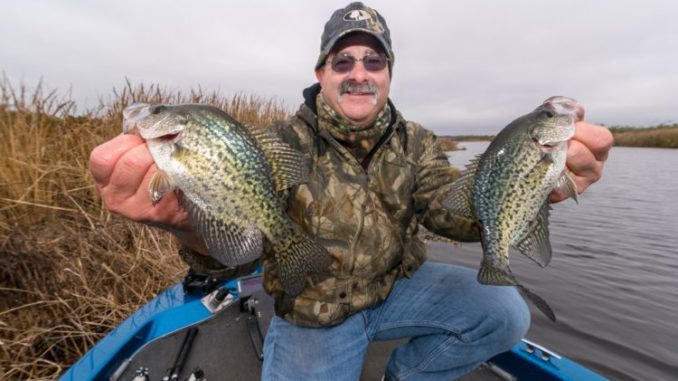
Weather systems dictate where to find crappie
The water was more than muddy when I stepped into Luling angler Tim Bye’s boat yesterday at the launch in Kraemer. It was putrid.
Monday’s downpours had washed mud from the surrounding cane fields into the system of canals between Lac Des Allemands and Lake Boeuf to turn much of the waters the color of sand.
But Bye wasn’t concerned: He and his wife had caught fish Sunday before the rains, so he knew it was just a matter of locating clean water. And by the end of the day, a small mess of sac-a-lait had piled up in his livewell.
The first stop was in Bayou Chactimahan at a laydown where he and his wife had located a pile of fish two days before — but the fish had deserted the muddy waters.
“It’s going to take a few days for the water to settle down,” Bye said. “Muddy water will push fish out of the bayous into the dead-ends.”
So we headed into the canals to the east of Lake Boeuf, finally locating a number of dead-end canals with pretty water.
We started fishing deep, with our jigs about 4 feet below pegged corks to work waters off the banks. Bye said sac-a-lait were holding deeper on his prior trip.
But conditions had changed in more ways than water clarity.
“This water is a foot higher than it was Sunday,” he said.
And water temps had risen into the mid-50s — an increase of between 5 and 10 degrees, depending on the location.
“It was in the 40s Sunday,” Bye said.
But several stops — including in some of his traditional honey holes, where he and his wife stuck gold Sunday — didn’t yield a bite.
It wasn’t until we pulled our corks down a couple of feet and threw right up on the banks that we found crappie willing to eat.
“The water temperatures have them pulled up,” Bye said. “Maybe they’re scouting things out.”
That was a bit of a surprise, since two days before everything had been deep. But in one respect, the angler said it made sense.
“These fish are ready to spawn,” Bye explained. “When I cleaned fish the other day, they were full of eggs.”
He doesn’t believe the crappie we caught were actually dropping eggs, but that they were “playing around” on the banks.
However, fish weren’t on just any bank. The key was finding a cut bank offering at least 2 feet of water. If hyacinths were pushed against the bank, that was even better.
Weather systems pushing through the state — such as the one forecast for the end of this week — are sure to push water temps down again. But Bye said it’s just a matter of adjusting your depth to continue catching fish.
“They aren’t going to go far,” he said. “They’ll just pull out and wait on the water to warm up again.”
And if there’s a prolonged warmup in the coming weeks, the bite could get frenetic.
“If that water hits 60 degrees, they’re going to move closer to spawning — and when it hits 65 degrees, they’re doing it,” Bye said. “If you go in a canal and (the water temp is) 65 degrees and you don’t catch any fish, there are not fish in the canal; they didn’t show up.”
Until that happens, he recommended looking for those cut banks where sac-a-lait will spawn and working 2 to 5 feet of water.
If you don’t get any takers, be certain to work all depths before moving spots because crappie won’t move a lot to eat.
“They won’t go down (to feed),” Bye said. “If they’re feeding, they might go up a little, but they’ll never go down.”
So this month he starts deep, and then works his way up to be certain he isn’t missing fish.
Once you get a bite, the odds are pretty good you’ll catch a few fish without moving.
“Wherever they’re at, they’re all together,” he said. “You can catch two or three, and if they stop biting you can come back later and there’ll probably be more fish there.”
If the water warms up enough to kick off spawning action, Bye said it’s not a prolonged affair.
“When they move up, they’ll spawn quick: Two or three days, and then they move back out,” he said.
So if you find fish right up on the bank one day and return and zero, just pull out and start working the depths.
Bye only fishes artificials, with his go-to being Panfish Assassin jigs.
“I don’t think color makes a difference,” he said.
His choice of poles is a 10-foot B’n’M crappie pole paired with the company’s West Point Trigger Reels.
“It allows you to get tight to cover. I can reach out and drop the bait right where I want it,” Bye said of the long rod. “But with that reel, I can also flip if I need to. It’s long enough you can go either way.”
He never uses a shorter casting rig.
“I’ll catch three fish to your one because you’re too busy reeling in,” he said.
